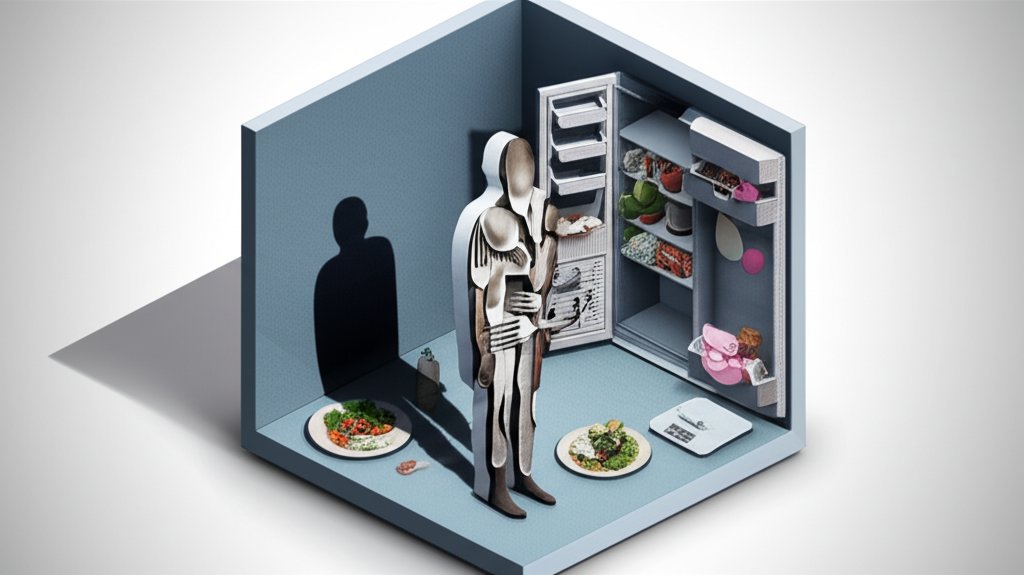The image of an eating disorder is often a young woman, frail and focused on a number on a scale. But what about the man spending three hours a day at the gym, meticulously tracking every gram of protein, and feeling intense anxiety if he misses a workout? The cultural script for male eating disorders is still being written, leaving millions of men struggling in silence, their condition misread as dedication or discipline. The truth is, these disorders are not a “female problem”—they are a human problem, with a unique and dangerous male-specific blueprint.
At a Glance: What to Know About Eating Disorders in Men
- It’s More Common Than You Think: One in three individuals with an eating disorder is male. In the U.S. alone, 6.6 million men will face one in their lifetime.
- The Goal is Different, The Obsession is the Same: The drive is often for a lean, muscular physique, not just thinness. This “muscularity-oriented” disordered eating is a key difference.
- Excessive Exercise is a Major Red Flag: While women may use purging, men are far more likely to use compulsive, excessive exercise as a primary compensatory behavior.
- Co-occurring Issues are Frequent: There’s a strong link between male eating disorders and substance abuse, anabolic steroid use, and a history of unreported trauma or bullying.
- The Risks are Higher: The mortality risk for men with eating disorders is 6 to 8 times higher than for men in the general population, and prevalence is rising faster than in women.
The Invisible Struggle: Why Male Eating Disorders Hide in Plain Sight
For decades, diagnostic criteria and societal awareness have been built around female presentations. This creates a dangerous blind spot where a man’s legitimate struggle is dismissed or misinterpreted.
The myth that eating disorders only affect women or gay men is one of the most significant barriers to diagnosis and care. This stereotype prevents men from recognizing the signs in themselves and stops family, friends, and even healthcare providers from asking the right questions. While rates are higher in gay and bisexual men—one study found 42% of male patients with bulimia identified as gay or bisexual—the vast majority of men with eating disorders are straight.
This cultural bias means that a man’s restrictive diet is praised as “clean eating,” and his hours in the gym are seen as “dedication.” He doesn’t fit the stereotype, so the underlying anxiety, obsession, and body dysmorphia go completely unnoticed until a serious medical crisis emerges.
The Drive for Muscularity, Not Just Thinness

While some men do pursue extreme thinness, a far more common obsession is the lean, muscular ideal championed in media and fitness culture. This focus on muscle gain, rather than just weight loss, fundamentally changes how the disorder presents itself.
This pursuit can lead to a condition called muscle dysmorphia (sometimes called “bigorexia”), a subtype of body dysmorphic disorder. It’s a debilitating obsession where an individual, regardless of how muscular they are, perceives themselves as small, frail, or insufficiently built.
This manifests in behaviors that look like a fitness fanatic’s routine on the surface but are driven by pathology:
- Compulsive Gym Attendance: Spending multiple hours a day working out, feeling extreme guilt or anxiety if a session is missed.
- Rigid Dietary Rules: Obsessively tracking macros (protein, carbs, fat), eliminating entire food groups, and revolving social life around eating schedules.
- Financial Strain: Spending excessive amounts of money on supplements, gym memberships, and specialty foods.
- Anabolic Steroid Use: Turning to steroids to achieve muscle gains that feel impossible naturally. In the U.S., over 2 million men have used them, with usage rates among young men nearly mirroring rates of anorexia and bulimia in young women.
This focus on building up the body is a critical distinction from the pursuit of “shrinking” often seen in female presentations. While the goal is different, the psychological torment is identical. The drive for thinness is still a significant factor for many men, especially those whose experiences are detailed in the guide to Distinct Anorexia in Males, but this muscularity ideal is a uniquely powerful force in the landscape of male eating disorders.
Distinct Risk Factors and Behavioral Red Flags in Men
Recognizing an eating disorder in a man requires looking for a different set of clues. The behaviors are often hidden behind a mask of health and masculinity.
A History of Weight Fluctuation and Bullying
Unlike many women who develop eating disorders, a significant number of men have a history of being overweight or obese as children or teens. The eating disorder can develop as a reaction to past bullying or shame about their previous body shape. The obsessive control over food and exercise becomes a way to ensure they never return to that state of vulnerability.
- Case Snippet: Mark, 32, was overweight throughout high school. After losing 80 pounds in college, he received constant praise. This praise became addictive. Now, he exercises two hours a day, weighs every meal, and experiences panic attacks if the scale ticks up even half a pound. His friends see him as a fitness role model, but internally he’s terrified of becoming “the fat kid” again.
The Central Role of Compulsive Exercise
For men, exercise is the most common “purging” or compensatory behavior. It’s socially acceptable and easily disguised as a healthy habit. The key difference is the compulsion behind it.
| Healthy Exercise | Compulsive Exercise |
|---|---|
| Feels good; provides energy and stress relief. | Feels like an obligation; causes anxiety if missed. |
| Flexible; you can skip a day without guilt. | Rigid; workouts happen despite injury, illness, or fatigue. |
| A part of a balanced life. | The center of life; dictates social and professional schedules. |
| Motivated by health and enjoyment. | Motivated by a need to “earn” or “burn off” food. |
Co-Occurring Conditions: A Tangled Web
Male eating disorders rarely exist in a vacuum. They are frequently intertwined with other serious mental and physical health issues.
- Substance Abuse: The link is alarmingly strong. Approximately 57% of men with binge eating disorder also have a substance abuse problem, compared to 28% of women. The substance can be a coping mechanism for the same underlying anxiety or a tool to suppress appetite.
- Trauma: About 30% of all patients with eating disorders have a history of sexual abuse. Due to intense social stigma, men are far less likely to disclose this trauma, leaving a core driver of their disorder untreated.
- Hormonal Imbalances: Anorexia nervosa often leads to significantly low testosterone and vitamin D levels. This not only has severe physical consequences, like a high risk for osteopenia and osteoporosis, but can also impact mood and libido. For some men questioning their sexuality, the resulting low libido from self-starvation can be an unconscious way to avoid confronting their sexual orientation.
A Practical Playbook for Taking Action

If you’re reading this and seeing yourself—or a man you care about—it can be overwhelming. Here’s how to move from recognition to action.
For the Individual: A Quick Self-Check
Ask yourself these questions honestly. There’s no judgment here, only awareness.
- Does my mood for the entire day depend on whether I had a “good” or “bad” food or workout day?
- Do I cancel plans with friends or family because of my workout schedule or dietary rules?
- Have I ever exercised while sick or injured out of fear of losing progress?
- Is a significant portion of my income going toward supplements, special foods, or gym-related expenses?
- Do I constantly compare my physique to others at the gym or on social media, always feeling like I fall short?
- Have I considered or used anabolic steroids or other performance-enhancing drugs to change my body?
If you answered “yes” to several of these, it’s a strong signal that your habits may have crossed the line from healthy to obsessive.
For Loved Ones: How to Start the Conversation
Bringing up this topic is delicate. Accusation or judgment will only build a wall.
- DO: Use “I” statements and focus on behavior. “I’ve noticed you seem really stressed about food lately,” or “I’m worried because you went to the gym even with that bad flu.”
- DON’T: Use labels or diagnose. Avoid saying, “You have an eating disorder” or “You’re obsessed with the gym.”
- DO: Express your concern for their well-being. “I care about you, and I’m concerned about how much pressure you’re putting on yourself.”
- DON’T: Comment on their body or appearance. Saying “You look great, you don’t need to worry” can invalidate their internal struggle and reinforce the problem.
- DO: Offer to help them find resources. “Would you be open to talking to a professional who specializes in this stuff? I can help you look for someone.”
Quick Answers to Common Questions
Let’s clear up some common misconceptions about male eating disorders.
Q: Isn’t this just an issue for gay men?
A: No. While gay and bisexual men are disproportionately affected, men of all sexual orientations develop eating disorders. The myth that it’s a “gay disease” is a harmful stereotype that prevents straight men from seeking the help they need.
Q: What’s the difference between being dedicated to fitness and having an eating disorder?
A: The line is crossed when dedication becomes obsession and flexibility becomes rigidity. Healthy fitness enhances your life; an eating disorder consumes it. If your physical and mental health, social life, and finances are suffering because of your fitness routine, it’s no longer healthy.
Q: Can men really get osteoporosis?
A: Absolutely. Anorexia, in particular, causes low testosterone and poor nutrient absorption, which is a direct path to low bone mineral density (osteopenia) and its more severe form, osteoporosis. This puts men at a high risk for fractures.
Q: What does gender-sensitive treatment for men look like?
A: It means moving beyond a one-size-fits-all model. Effective treatment for men often includes:
- Male-Only Therapy Groups: Creating a space where men can talk openly about body image, pressure, and sexuality without feeling like an outlier.
- Addressing Steroid Use: Having clinicians who understand the cycle of steroid use and can address it as part of the treatment plan.
- Focus on Function and Health: Shifting therapy goals from weight to functional strength, health markers (like hormone levels), and developing a balanced relationship with exercise.
Your Path to a Healthier Relationship with Food and Body
Recognizing that there might be a problem is the hardest and most important step. Male eating disorders thrive in silence and stigma, but they are treatable. The path forward involves acknowledging the unique pressures men face and seeking care that understands them.
Your next steps don’t have to be massive. They can be small and deliberate.
- Acknowledge the Struggle. Admit to yourself that your relationship with food, exercise, or your body is causing you distress. Name the problem without shame.
- Find a Specialist. Seek out a therapist, dietitian, or doctor who has specific experience with male eating disorders. Ask them directly: “What is your experience treating men?” “How do you adapt your approach for male-specific issues like muscle dysmorphia?”
- Be Radically Honest. In treatment, it is vital to be open about all behaviors—not just food restriction, but compulsive exercise, supplement and steroid use, and any substance use. The full picture is necessary for a full recovery.
The road away from an eating disorder is not about abandoning fitness or health. It’s about reclaiming them from the grip of obsession and finding a way to live a strong, full, and flexible life where your worth isn’t measured by a barbell, a macro count, or a reflection in the mirror.
- Bento Box Trays Streamline Restaurant Meal Presentation and Transport - December 13, 2025
- Plastic Bento Boxes Face Scrutiny Over Sustainability Impacts - December 11, 2025
- Bento Tray Revolutionizes Organized Meal Transport and Presentation - December 10, 2025










